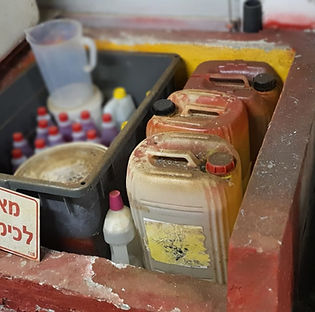
Consultation for Management and Storage of Hazardous Materials
Many businesses, organizations, and industrial facilities store hazardous materials that must be managed and stored in accordance with the requirements of the Ministry of Environmental Protection.
Improper handling or storage can lead to the leakage of toxic substances, putting employees, the public, and the environment at risk.
According to the Hazardous Substances Law (1993), any business that uses hazardous materials is required by law to obtain a Poison (Hazardous Materials) Permit. This permit details the specific types, concentrations, and quantities of hazardous substances that the business is authorized to hold.
The list of substances considered hazardous (including substances that are mixed or blended with others) appears in the second appendix to the law.
The permit also categorizes the materials according to risk level, from A (the highest) to D (the lowest), which determines the required level of supervision and the validity period of the permit.
Whenever a business wishes to make any change, even a minor one, to the types, concentrations, or quantities of hazardous substances in its possession, it must notify the Ministry of Environmental Protection.
Strict compliance with the Poison Permit conditions will help ensure the proper storage and management of hazardous substances, preventing the risks associated with poor handling.
Any business holding a Poison Permit is also required to designate a responsible Hazardous Materials Officer, whose role is to monitor compliance with Ministry requirements and ensure that all hazardous materials within the business are managed according to regulations.
.jpeg)
.jpeg)

How Should Hazardous and Toxic Materials Be Stored?
The storage of hazardous materials requires strict management, as these substances, whether toxic, explosive, or corrosive, can pose significant health and environmental risks if not handled correctly.
Therefore, if a facility wishes to store hazardous materials, it is highly recommended to consult with a specialized company for project management.
Sutok Environmental Engineering has extensive experience in managing the planning and construction of standard-compliant containment facilities, including meeting all fire safety and regulatory requirements.
Proper planning of a storage facility should take the following parameters into account:
-
Designating a suitable and safe location for storing materials, with specific attention to the type of hazardous substance. Each material has unique storage requirements: enclosed spaces, open areas, or semi-enclosed spaces.
-
The storage structure must be made from rigid, non-combustible materials. For flammable substances, internal or external walls and partitions must be built from fire-resistant materials.
-
The facility floor should be made from impermeable materials, with raised edges or a drainage system to prevent leaks of hazardous substances outside the facility in case of a spill.
-
The building should have both natural and forced ventilation, with doors that open outward.
-
Emergency lighting must be installed and activated in low-light conditions.
-
All electrical devices should be explosion-proof, both within the facility and in the material transport zone for flammable substances.
For further information on this subject, contact us at Sutok Environmental Engineering. Our team of experts provides professional consulting throughout the entire process and regulatory procedures.
Proper storage of hazardous materials is of the utmost importance to ensure optimal and safe management for employees, the public, and the environment.
